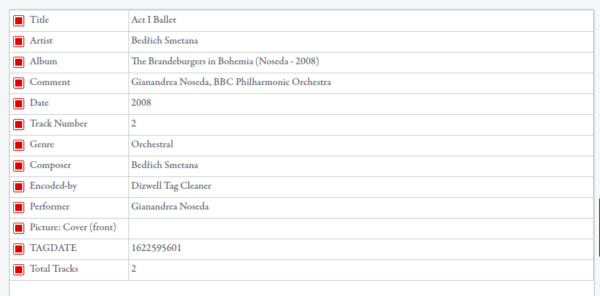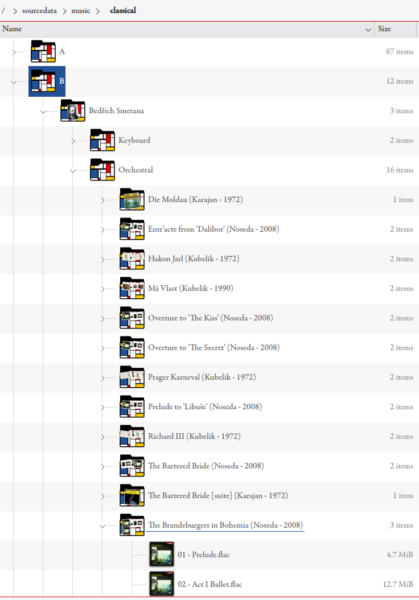 A reader recently got in touch to ask about my Axioms of Classical Tagging article, giving me the strong impression that my article makes it all sound too hard to tag things correctly... and I think he may have been right on that score! So I thought I'd simplify that article here, reducing its long, discursive justification of things to a few simple principles. If you want to understand why things should be as I'm about to spell it out, read the full article. For a short-cut guide to tagging correctly, however... read on!
A reader recently got in touch to ask about my Axioms of Classical Tagging article, giving me the strong impression that my article makes it all sound too hard to tag things correctly... and I think he may have been right on that score! So I thought I'd simplify that article here, reducing its long, discursive justification of things to a few simple principles. If you want to understand why things should be as I'm about to spell it out, read the full article. For a short-cut guide to tagging correctly, however... read on!
There are just three basic principles to grasp from the outset, namely:
- The basic 'unit' of organising a digital classical music library is: the composition, not the CD. It doesn't matter if a recording of one symphony is supplied on the same CD as another. They are two unique and distinct compositions, and need to be filed apart from each other accordingly. The physical CD is irrelevant when cataloguing your music.
- The extended composition name is a combination of ordinary composition name, plus the surname of the conductor (or other principal artist), plus the recording year. It doesn't have to be the conductor: in a flute concerto, the surname might be that of the flautist; in an opera, it might be that of the prima donna. But usually, the conductor's surname will act as the 'distinguishing recording artist', making this recording of a composition unique from any other.
- The physical model (i.e., the folders you store music files in) must follow the logical model (i.e., the stuff you put into your metadata tags), and vice versa. Specifically, the physical folder structure should be in the form: composer-full-name/genre/extended-composition-name. So you end up with something like Edward Elgar/Symphonic/Symphony No. 1 (Boult - 1968).
Once those principles are understood and accepted, the way you tag your music really follows as a mere direct consequence. Specifically:
- The extended composition name in the physical folder structure should be identical to the contents of the ALBUM tag. Thus, ALBUM="Symphony No. 1 (Boult - 1968)".
- The genre in the physical folder structure should be identical to the contents of the GENRE tag. Thus, GENRE="Symphonic".
- The composer full name in the physical folder structure should be identical to the contents of the ARTIST tag, Thus, ARTIST="Edward Elgar".
- The full name of the 'distinguishing recording artist' should go in the PERFORMER tag, but it's optional to do this. Thus, PERFORMER="Adrian Boult".
- The COMPOSER tag always matches the ARTIST tag, identically, though it's optional to have a COMPOSER tag at all. Thus COMPOSER="Edward Elgar".
- The TRACKNUMBER tag is a number starting at 1, incrementing in steps of 1 for each track that makes up a recording. A traditional symphony will therefore probably end up with TRACKNUMBER tags labelled 1, 2, 3 and 4. If there are more than 9 tracks to a recording, pad the digits with leading zeroes, so you get TRACKNUMBERS of 01, 02, 03...10, 11, 12 and so on.
- The TITLE tag contains (usually) the tempo indication for the matching movement (i.e., TITLE="Andante. Nobilemente e semplice - Allegro"). For non-orchestral works (such as operas, lieder, song cycles and so on, the identifying first line of text of the song or aria might be appropriate, such as TITLE="On a Poet's lips I slept").
- The COMMENT tag is used to store free form text describing the conductor, orchestra, choir and other soloists that might be performing the work, in a comma-separated list. The conductor always comes first, then the orchestra, then choirs, then vocal and instrumental soloists. Soloists have their function in brackets after their name (the function is either the name of the instrument they're playing, or perhaps the character they're playing, if it's an opera). Thus: 'Marissa Robles (harp)' or 'Peter Pears (Captain Vere)'.
There is no need for any more tags than this (though different programs might embed some extra ones of no significance for the present discussion), and all the album-wide tags have corresponding entries in the physical path-and-folder name where you store the actual FLAC files. Thus, COMPOSER and ARTIST tags match the first part of the physical folder name; GENRE matches the second part; ALBUM matches the third. Parts of the ALBUM also go on to determine what gets written into the PERFORMER and YEAR tags. That is, if the ALBUM ends "...(Boult - 1968)..." then 'Adrian Boult' will be the PERFORMER, and '1968' will be the YEAR.
Within a folder of music, too, the TRACKNUMER and TITLE tags will pretty much exactly match the full physical file name. That is, if I've tagged a file as being TRACKNUMBER='1', TITLE='Allegro con brio', then I will expect to see a physical file name of '01 - Allegro con brio.flac' in my file browser.
Putting it simply, if I see this in a tag viewer:
...then, I see ARTIST = Bedřich Smetana, ALBUM = The Brandeburgers in Bohemia (Noseda - 2008), GENRE = Orchestral, YEAR/DATE = 2008, and PERFORMER = Gianandrea Noseda. From that, I can expect to see a folder called /Bedřich Smetana/Orchestral/The Brandeburgers in Bohemia (Noseda - 2008). Within that folder, I expect to see a file called 02 - Act I Ballet.flac (since those are the Track Number and Title tags). Here's what I actually see in my file browser:
It is almost precisely as predicted, because my logical and physical data models are consistent with each other. The one mandates or implies the content of the other, in either direction: that way, I can browse my music collection from an operating system's file manager or a music player's library display in exactly equivalent ways.
And that's it, really: I'm not sure I can make it any simpler than that! But let me know if you can...


Mr. Rogers:
Thank you for your articles on classical music organization and tagging. They helped me cut a Gordian knot with which I've been struggling. Because I'm generally insubordinate, I didn't agree fully with your process, but that's of no importance. I found two things of particular interest: your concept of "Distinguishing Artist", and your use of overloading of the "Album" tag to hold the composition name.
But I don't understand your rejection of the "AlbumArtist" tag. You were happy enough to overload and repurpose the "Album" tag with composition name, and for your purposes it made perfect sense. I was unable to find the "Performer" tag, which you mention as essential, in the ID3v2.3 specification, and it's not supported without customization in the music library software I've tried. You've overloaded one tag already; why not additionally overload "AlbumArtist" with Performer in the sense of Distinguishing Artist?
Despite my one reservation about tags, your articles on music tagging were very useful to me, and I thank you for providing them.
Best wishes,
D. O'Neill
Hi D: Thanks for commenting...
The ALBUM ARTIST tag is, unfortunately, used by a lot of software, but how it's used is extremely variable. Section 2.2 of my article on the Axioms of Classical Music tagging makes the matter clear... (https://absolutelybaching.com/music-articles/the-axioms-of-classical-music-tagging/):
If you put "x" in ARTIST and "y" in ALBUM ARTIST, then some music playing software will display x, some will display y, and some might display one or another with the hint that the other exists. But it's not a given what will happen! So there's that (and it's probably the most important point: you cannot rely on one piece of software interpreting the co-presence of ARTIST and ALBUM ARTIST in the same way. That, practically, means you avoid using both of them at the same time).
The more philosophical problem is that, in classical music, we do not have 'albums'. We have compositions, or recordings of compositions. But the concept of an 'album' (the clue is in the name) is a modern invention of popular music. If we are not tagging pop music, we have no need of anything associated with 'albums'. I do not recommend using DISC NUMBER for the same reason: the physical medium on which music is supplied is irrelevant. Likewise, an "album" is a construct of a particular part of the music industry: it is equally irrelevant for classical musical listeners.
I suppose the third axis of my argument against ever using ALBUM ARTIST is, simply: it's not needed. If you can do everything you need to do to make your music recordings unique and discoverable without touching it (and you can), then why bother using it in the first place? If it's not necessary to use it, but it causes functional problems for different music players if you do, and in any case doesn't doesn't correctly reflect the unique requirements of classical music tagging versus non-classical tagging... then it seems pointless to use it.
All that said, I would argue that I do not 'overload' or re-purpose the ALBUM tag! It's more a simple matter of understanding and describing what an 'album' is, in a classical music context. Namely, it's a unique recording of a composition -and, accordingly, must contain all the attributes of a recording that make it unique (i.e., ordinary composition name, plus some indication of whose recording it is, and when they're making it). I know why you call that 'overloading': it brings back happy memories of overloading PL/SQL procedures and such like! But I would regard it more as merely 'realising what the unique key for classical music is and fitting it in wherever is most appropriate'!
As for PERFORMER: I came to that late and am in no way wedded to it. If you prefer to dispense with it, be my guest. It wasn't in my original 'axioms' and I wouldn't insist on it even now. See Axiom 6 in my Axioms article and also https://absolutelybaching.com/distinguishing-artists/. That last article, in particular, I hope demonstrates that I don't love the PERFORMER tag, and I rather wish it weren't needed, and I'm not convinced it *is* needed... but, if the only place you've got 'Werner von Karajan' as a performer listed is in the COMMENT tag, and he's listed as merely one item in a comma-separated list, your music playing software might not always be able to find him in there. My tagging guidelines would, for example, have you tag a symphony up in the COMMENT tag as 'Wener von Karajan, Ukraine Symphonie Orchester'. Now, the word Karajan there is glued to a closing or trailing comma: can your software find Karajan without a closing comma? Most music playing software I know of can, so it's no big deal. But I recognised the fact that some software might demand an exact match and thus effectively require you to always search for Karajan, (with the trailing comma). That would be unfortunate! I accordingly, late in the day, came to accept that putting the primary artist's name in a separate tag field, naked and without commas, might be useful, in the same way that recording DATE, whilst already present inside brackets in the ALBUM tag, would be easier to search and filter by if it was stored 'naked' in the YEAR or DATE tag, too.
But my own Giocoso player wouldn't be fooled by extraneous commas, and most of the playing software I am regularly familiar with also wouldn't be... so if you want to drop PERFORMER, be my guest. As it merely duplicates information that's actually recorded elsewhere, it's actually a data modelling abomination in the first place, if we're being technical about it!
Short version: PERFORMER is a highly optional, data-modelling-doubtful, pragmatic concession to the way some software might work.
Summing up: yes, I allow for a PERFORMER on very pragmatic grounds. But I forbid an ALBUM ARTIST on very functional grounds (namely, that different players display ARTIST and ALBUM ARTIST differently, and differently again if both are present). The reluctance to use ALBUM ARTIST is therefore based on acquired knowledge that its presence causes music playing software to do the wrong thing.
Also, a footnote: You mention not finding 'PERFORMER' listed in the ID3v2.3 tagging standard. True enough, but that tagging standard is meant for MP3s. It doesn't apply to FLACs, which don't use those tags at all, but use a completely separate tagging mechanism ("Vorbis Comments" if we're being pedantic!) And PERFORMER is definitely in the 'approved list' of Vorbis Comments, as this page shows. Funnily enough, ALBUM ARTIST is not in that list! But that's not the reason I recommend not using it 🙂
Hello, I very much appreciate your thoughts on tagging classical music as I had been struggling with it on my own. And I was happy to download EAC and mp3tagger as you suggest for us Windows users. I do have a question, though, on your recommendation for a decent Windows music player? I have been using Media Monkey for several years but am running into more and more problems with it as they "improve" it, although many of these may no longer be an issue if I use the standalone ripper and tagger. As much as I'd love to switch over the Linux I am afraid that is beyond me at this point. Thank you for all of your efforts in classical music organization!
Hi Karen, Thanks for your kind comment, and it's certainly nice to know that I've been of use, even to Windows-only users! You're right that switching to Linux is a big ask, and though I am philosophically keen on open source and would wish more people to switch to an open source operating system, I know it's a bit unrealistic to expect it to happen often!
A recent reader got me to look at Media Monkey again after many years: I'd actually rate it higher now than I did back in about 2018 when I wrote my comparative review -on the strict understanding, however, that I dabble with it occasionally, not live with it daily. So, if your experience with its 'improvements' hasn't been great, I'd certainly bear that in mind and encourage others to do likewise. Personally, I still prefer Foobar2000 (though it's quite dull to look at, it's audio management and playback capabilities is nigh-on perfect) or MusicBee (very visually pleasing, though perhaps too fussy for my own tastes... but then I'm a command-line nut at the best of times!)
Really pleased to hear from you, anyway, and appreciate the feedback enormously.